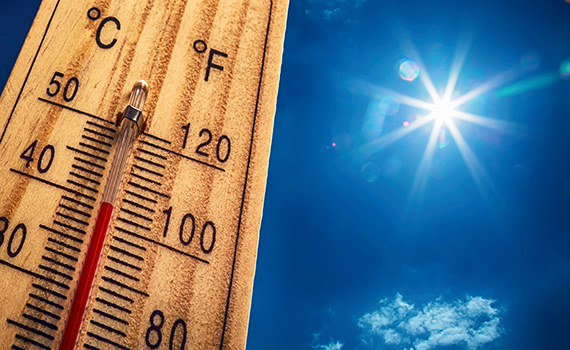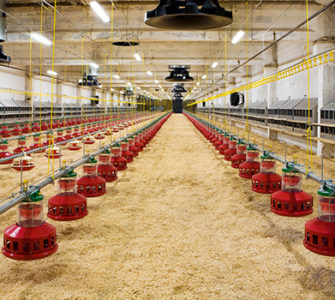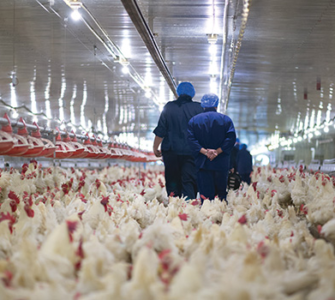Prepare now for summer heat, humidity
By Tom Tabler, PhD
Extension Professor
Mississippi State University Extension Service, Poultry Science Department
Mississippi State, Mississippi
High temperatures and increased humidity during summer months are a dangerous combination for poultry flocks from Arkansas and Texas to Maryland and Delaware. Now is the time for growers to take precautions that will help birds survive the long, hot days ahead.
Some of these precautions require a small expense — such as purchasing new fan belts to keep on hand — while others only require an investment of time. Taking action now, between flocks or while birds are small, can save you a lot of headaches in the months ahead and help ensure your birds perform optimally.
Air speed is critical
The top priority should be directed toward your ability to minimize heat stress when you need to. Birds today don’t perform well if they’re overheated. A sufficient amount of uniform air speed is critical to keep them alive. A 400 ft/min air speed down the house that used to be fine just a few years ago is no longer enough. Modern, tunnel-ventilated broiler houses often reach 600-700 ft/min with some new houses capable of 900-1,000 ft/ min, and every bit of it is needed.
Fans are our first line of defense against high summertime temperatures. Air movement provides 75% or more of the cooling produced in a tunnel-ventilated poultry house. However, any fan is only as good as its belt. Loose belts can’t spin fan blades at maximum revolutions per minute and increase wear on the pulley. Belts should ride slightly above or flush with the top of the pulley.
Fan belts should be replaced once a year and more often if they are riding low in the pulley. Pulleys can also become worn and develop a “U” shape instead of a “V” shape. If this happens, they should also be replaced.
Keep fan blades and shutters clean. I’ve spent many dirty hours between flocks washing fans and shutters, but it helps keep chickens alive. Dirty shutters can reduce airflow by as much as 30%. And don’t forget the bearings. Some bearings are sealed, but some have a grease fitting and should be re-greased twice yearly, in spring and fall. Dry bearings require more power to turn the blades, which reduces efficiency.
Cool-cell system
Sufficient air speed is critical, but during extremely hot weather, you need a second line of defense in the form of a cool-cell system which, like fans, requires maintenance.
If cool-cell pads are clogged, static pressure is increased, which forces fans to work harder. That in turn reduces airflow and decreases cooling. Flutes should be free of dust, cobwebs and, particularly, mineral deposits. Take care not to make matters worse by blowing grass clippings from your mower or brush hog toward the pads and into flutes, which restricts airflow.
The pad area should be matched to the number and size (cfm output) of fans in the house. To check if pads are properly cleaned, measure the air speed in the center of the pad system with all of the tunnel fans on. For a 6-inch pad system, air speed should be between 350 and 400 ft/min directly in front of the pads. If the air speed is higher than this, you likely have a blockage in the pads or the pad space may not match the tunnel-fan capacity.
Slow air speed and high humidity in front of the pads usually results in wet litter, despite efforts to keep litter dry. Use migration fences to prevent too many birds from crowding into the cool-cell area.
Make sure holes in the distribution header pipe along the top of the pads remain free of debris. Flush the distribution line before charging the system in the spring to remove dirt or debris that may have accumulated over the winter. Those holes need to be monitored closely whenever the pads are in use so any clogs in holes can be eliminated. You can easily tell when you have clogged holes because you will have dry streaks on your pads where the clogged holes are.
The entire pad should get wet when the distribution header pipe is operated.
Direct sunlight on the pad system can result in algae growth that can restrict airflow. There are products available to prevent algae growth. Check with your service tech to see what products are approved for use by your integrator.
Nighttime cooling
As the heat of the day subsides, allowing some fans to drop back at night may save a little electricity, but it can cost significant performance losses, in part because humidity is much higher at night than it is in the afternoon.
Birds still rely on water evaporation off their respiratory system to cool themselves in hot weather, regardless of air temperature. When humidity levels are high, this evaporation becomes nearly impossible. The bird pants and works hard but gets little relief, thus increasing heat stress.
Maintaining high airflow by running additional fans all night long after birds are at least 35 days old can increase the amount of heat loss. Typically, growers lock tunnel fans on at night to prevent them from shutting down as the temperature cools at night, and this is fine as long as the integrator agrees. However, monitor nighttime temperatures. If you have too many fans locked on and there’s a cool night, the controller wants to transition to side-inlet ventilation and static pressure gets too high.
You can also lower the controller’s set point temperature by 5° or so to keep additional fans running at night — or set the tunnel fan OFF temperature several degrees below the ON temperature (instead of the typical 2°) to delay the fan turning off as the outside temperature drops at night. I’ve used all of these methods over the years and they all work.
Consider sprinklers
Evidence from the University of Arkansas and Mississippi State University continues to support sprinklers as a successful way to significantly reduce cooling-water use while maintaining flock performance.1-3
Combining sprinklers with cool cells can improve performance and conserve cooling water. Sprinkling allows you to maintain lower house humidity levels and take advantage of the wind-chill effect of the water sprinkled on the birds. In addition, birds often stand up and release trapped heat while being sprinkled, which helps maintain eating and drinking activity. It’s critically important, however, to monitor sprinkling intervals to ensure birds have time to dry off between sprinklings.
Sprinklers can become the main method of water-related cooling, with cool cells used only in extreme conditions. House temperatures that approach 90° F (32° C) result in lower house humidity levels, reduced mortality, better performance and enhanced cooling-water conservation. In fact, it’s been estimated that sprinkler technology can save up to 50% of cooling-water usage and reduce in-house relative humidity by 20%.4
Other pre-summer chores
Here are a few other chores to be done to help get ready for summer weather and ensure flocks do well.
- Check the belt tensioner on all of your fans and repair or replace if necessary.
- Seal hot air leaks. All air entering the house should be coming through cool cells in hot weather. Seal leaks in the vapor-barrier ceiling, around entrance and loadout doors and any hot air that’s bypassing the cool-cell pads through the dog house.
- Make sure tunnel curtains and doors are fully open to prevent airflow restrictions.
- Don’t forget the backup generator. Be on the farm when it runs or check the hour meter each week to make sure it’s exercising and will be available if needed. Check the battery and fuel supply regularly and keep spare fuel filters handy. Always keep the fuel tank at least half full.
- Be aware that lead fans (the fans closest to the evaporative pads) perform the worst when the house is in tunnel mode. If possible, set the system so tunnel fans that are the farthest from the inlet — those across the back-end wall — come on first and sidewall fans come on later. If all of your fans are in the sidewalls, stage it so the fans farthest from the cool-cell inlets come on first, and then work back toward the inlets.
- To avoid damage to pads used daily, change the water once per week in the sump tank to prevent mineral, scale and pH buildup.
- Clean filters and strainers on the cool-cell system to prevent water restriction to pads.
- Keep grass cut in front of pads to prevent airflow restriction to the pads.
- Consider how many tunnel fans should be running before cool cells come on. There’s much debate on this topic. Personally, I think all tunnel fans should be on before the cool cells come on, but again, there are many strains of thought on this so go with what your integrator recommends.
- Keep spare parts — fan belts, fan motors, sump-pump motors, water filters, PVC pipe fittings, circuit breakers, etc.
- Monitor your breaker panel for signs of overheating, particularly the main breaker and breakers for fans and the sump pump. An infrared temperature gun is relatively inexpensive (~$100) and provides a quick way to find overheating breakers. If breakers are tripping due to overheating, you need a qualified electrician to tell you why and fix the problem.
- Verify there’s adequate water pressure and volume to supply both drinkers and cool cells. Make sure your backup water supply is available and can be called upon immediately if needed.
- In addition to all of the above, pullet growers must also worry about light traps. Monitor the house static pressure and verify that light traps are not restricting airflow.
- I would suggest not allowing water over the cool cells until the house temperature reaches 84° F to 85° F (28.8° C to 29.4° C) instead of the typical 80° F to 82° F (27° C to 28° C). This will mean the house is slightly warmer, but humidity will be lower and you can save cooling water while still maintaining performance.
- Do not neglect your year-round projects such as maintaining biosecurity. Keep footbaths fresh and effective throughout the summer. Rodents carry disease and cause structural damage to your facilities, so monitor bait stations regularly and keep fresh bait out as needed.
If you take steps now to prepare your houses for hot weather, you’ll find long, hot summer months easier to manage, and your birds will be a lot more likely to survive and perform at their best.
1 Liang Y, et al. Cooling broiler chickens by surface wetting: Indoor thermal environment, water usage, and bird performance. Appl. Eng. in Agri. 2014;30(2):249-258.
2 Tabler T, Liang Y, Wells J. Sprinklers offer flock cooling benefits and water conservation opportunities. Mississippi State University Extension Service Publ. No. 3351. 2019 April.
3 Moon JW, DuBien J, Brown AT, Liang Y, Tabler T. Water conservation and production benefits of sprinkling broilers. Int. Poultry Scientific Forum. Poster P269. Abstract. Atlanta. 2020 Jan 27.
4 Ibid.
Posted on May 5, 2020

















